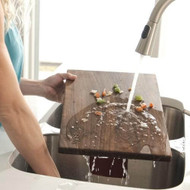Stop Putting Your Cutting Board in the Dishwasher
Posted by Grant Chen on 17th Oct 2024
A common question that often comes up with home chefs is, “Should I put my cutting board in the dishwasher?”. The short answer is: no.
The long answer is that there are proper ways of cleaning your cutting board, which depend on the type material the cutting board is made out of. Here’s the list of common cutting board types and how to clean each of them:

Wood Cutting Boards (maple, oak, cherry, walnut, etc)
Wood is by far the most popular material for cutting boards. Most wood cutting boards are either made up of glued up edge grain or end grain blocks of wood. The main reason you should never place a wooden board into your dishwasher is that the prolonged exposure to heat and water will cause your cutting board to warp and crack. Not only will it be difficult to chop on a warped board, but cracks in the wood are a breeding ground for bacteria, mold and other microbes that feed on trapped food particles and water.
The safe and proper way to clean a cutting board is to wash it like any regular dish, using plenty of hot water (the hotter, the better), soap and mechanical scrubbing ( aka “put your elbow into it!”). If the board has been exposed to raw meat, then after you’re done washing, use a sanitizing solution of 1 part vinegar, 4 parts water and wipe the board down, then pat dry. If you want to be extra sure, then the USDA Recommendation is to soak your board in a solution of 1 tablespoon of bleach per gallon of water for a few minutes, then dry it with cloth or paper towels.
One of the most important aspects of maintaining a wood cutting board is to keep it properly oiled. By oiling your cutting board, you are extending the life of the wood by preventing it from cracking due to excessive dryness and protecting against wood warping (also known as cupping) due to a rapid change in the wood moisture content. If you leave your board dry too long and suddenly expose it to water, that is usually the culprit behind a warped cutting board. If you notice knife cuts in your wood cutting board, you can also fill the tiny holes and cuts with cutting board wax to prolong the life of your cutting board.
The other reason to regularly oil your cutting board is for sanitation, as a well oiled board will resist foreign liquids, such as blood and associated bacteria from soaking into the wood. You should always use a food safe or food grade mineral oil and never vegetable oils, as it will spoil and cause your cutting board to stink.
(adsbygoogle = window.adsbygoogle || []).push({});

Plastic Cutting Boards
The major benefit of plastic cutting boards is that you can put plastic cutting boards in the dishwasher, as they will not warp or crack (minus the thin plastic sheets). This is actually the recommended method for plastic cutting boards, as there is generally more knife scarring with plastic boards, which lead to more nooks and crannies for bacteria to hide in. Note that not all dishwashers
The other option if a dish washer isn’t available or preferred, is to clean with hot water and soap as usual, then dunk your board in bleach or vinegar sanitizing solution for a few minutes. Unlike a wood board, you can leave your plastic board in for as long as you want, though 5 minutes is probably all you need to make sure that it’s properly sanitized.
Glass Cutting Boards
Similar to plastic, glass boards can also be put into the dish washer, given that glass is a tough material that will not warp. That said, we at CuttingBoard.com always feel impelled to mention the fact that glass cutting boards should be for decoration or light use only, as your knife blades will eventually become dull if used against glass boards. You should never, ever use a hard blade such as ceramic on glass, as there is an extremely high risk of chipping your knife and having dangerous knife particles in your food!
Bamboo Cutting Boards
While most people lump bamboo boards along side wood (hint: bamboo isn’t technically considered a wood), bamboo cutting boards do behave mostly the same way as wood. Bamboo boards are made using a special method that requires a fair amount of glue and pressure treatment to flatten the bamboo, which in turn makes them especially vulnerable to the heat and water inside a dish washer. If you put a bamboo board in the dish washer, don’t be surprised if you eventually need a new one.
That said, bamboo cutting boards are extremely tough and dense otherwise compared to most hardwoods, so a little bit of TLC with a bamboo board will go a long way!

